Ordering Number: AS24578
Wakizashi in Shirasaya with Koshirae (NBTHK Hoozn Token)
Inscription:
Bishu Osafune Sukesada 備州長船祐定
Eisho r nen 8 gatsu hi 永正六年八月 (August, 1509)
We divide works in to Saijo Saku, Jyojyo Saku, Jyo Saku,and Regular Saku.
This piece is ranked as Jyojyo Saku for Osafune Sukesada.
Habaki: double silver habaki
Blade Length: 51.4cm ( in)
Curvature: 1.8cm (in)
Mekugi hole: 2
Width at Base(Motohaba): 2.89cm(in)
Width at tip(Sakihaba): 1.97cm(in)
Thickness: 0.87cm (in)
Blade Weight: 520g
Era: the mid-Muromachi period
Shape: Thick blade with deep curveture. Bohi is carved on the both sides of blade.
Jigane: Ko-itame hada with faint Utsuri
Hamon: NIoi base Gunome and Choji midare. Boshi is rounded and Yakizume.
Features: Osafune Sukesada group was a school of swordsmiths active in the late Muromachi period.
During this time, Japan was in the midst of the Sengoku period, leading to a high demand for swords.
Many blades were produced in regions such as Bizen and Mino.
It is said that there were more than a dozen swordsmiths who used the name Osafune Sukesada, and they produced large number of swords, and the quality varies from piece to piece.
Koshirae: Handachi Koshirae
Tsuba: rounded iron tsuba with brass inlays of plants.
Menuki: a picture of a monckey trying to ride a horse.
From Aoi-Art: Sukesada is often referred to as "mass-produced" due to the large number of works. This piece made in the Eiroku era, relatively early among them, is of comparatively good workmanship.
This piece has notable length and curvature for a Wakizashi, suggesting that it was likely made as a sword for one-handed use.
The Koshirae is well-crafted, and the design of the Menuki in particular is quite charming.
NBTHK Hozon Certificate
Aoi-Art estimation Paper
whole Oshigata
Auction Starting Price:500,000JPY
Place Bid
Related Items:
 Wakizashi: Bizen Koku Ju Osafune Genbei no Jo Sukesada Saku Eiroku 11 Nen 8 Gatsu Kichijitsu (NBTHK Tokubetsu Hozon Token)
Wakizashi: Bizen Koku Ju Osafune Genbei no Jo Sukesada Saku Eiroku 11 Nen 8 Gatsu Kichijitsu (NBTHK Tokubetsu Hozon Token)
 Daisho: Yozayemon Jo Sukesada & Harima Daijo Tadakuni (NBTHK Certificates)
Daisho: Yozayemon Jo Sukesada & Harima Daijo Tadakuni (NBTHK Certificates)
 Wakizashi:Bizen Koku Osafune Yosazaemon Sukesada(NBTHK Tokubetsu Hozon Token)
Wakizashi:Bizen Koku Osafune Yosazaemon Sukesada(NBTHK Tokubetsu Hozon Token)
 Wakizashi:Sukemitsu (Bizen, Early Muromachi Period)(NBTHK Hozon Token)
Wakizashi:Sukemitsu (Bizen, Early Muromachi Period)(NBTHK Hozon Token)
 Wakizashi: Bishu Osafune Yukikane Saku
Wakizashi: Bishu Osafune Yukikane Saku
 Wakizashi: Bishu Osafune Norimitsu Saku(NBTHK Tokubetsu Hozon Token)
Wakizashi: Bishu Osafune Norimitsu Saku(NBTHK Tokubetsu Hozon Token)





